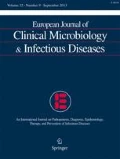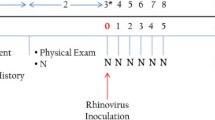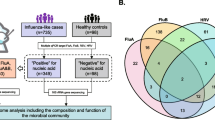Abstract
The nasopharynx is the primary site of colonization by respiratory pathogen that constitutes the port of entrance in the respiratory tract. The role of mucosal respiratory microbiota in infection has been recently emphasized; therefore, we aimed to assess if a specific respiratory microbiota profile was associated with symptomatic infection and/or with presence of respiratory viruses. We performed a case-control study to characterize the healthy respiratory microbiota and its alteration during acute viral infections. Next-generation sequencing of the 16S rRNA gene was applied to 225 nasopharyngeal samples from 177 patients with viral respiratory infection and 48 matched healthy controls. We evidenced an important decrease of bacterial alpha-diversity in patients with symptomatic respiratory infection and a loss of the healthy core microbiota, specifically anaerobes and Prevotella spp. Moreover, eight respiratory pathogens were enriched in these patients, including Staphylococcus aureus, Haemophilus influenzae, Streptococcus pneumoniae, Moraxella catarrhalis, Dol osigranulum pigrum and Corynebacterium propinquum/pseudodiphtheriticum, whose role in respiratory infection is unclear. The asymptomatic carrier of influenza harbors a microbiota similar to healthy subjects, suggesting a critical role of microbiota in the clinical expression of viruses. These data suggest that the commensal microbiota plays a significant role in susceptibility to viral infection. The frequent co-detection of virus and bacteria raises the question of a strategy to prevent bacterial disease, focusing on the prevention of nasopharyngeal colonization through effective antibiotic treatment. In addition to antibiotics, further studies should test preventive or therapeutic interventions for maintaining or restoring a healthy nasopharyngeal microbiota.




Similar content being viewed by others
References
Byington CL, Ampofo K, Stockmann C, Adler FR, Herbener A, Miller T, Sheng X, Blaschke AJ, Crisp R, Pavia AT (2015) Community surveillance of respiratory viruses among families in the Utah better identification of germs-longitudinal viral epidemiology (BIG-LoVE) study. Clin Infect Dis 61(8):1217–1224
Skevaki CL, Tsialta P, Trochoutsou AI, Logotheti I, Makrinioti H, Taka S, Lebessi E, Paraskakis I, Papadopoulos NG, Tsolia MN (2015) Associations between viral and bacterial potential pathogens in the nasopharynx of children with and without respiratory symptoms. Pediatr Infect Dis J 34(12):1296–1301
Man WH, de Steenhuijsen Piters WA, Bogaert D (2017) The microbiota of the respiratory tract: gatekeeper to respiratory health. Nat Rev Microbiol 15(5):259–270
Yi H, Yong D, Lee K, Cho YJ, Chun J (2014) Profiling bacterial community in upper respiratory tracts. BMC Infect Dis 14:583
de Steenhuijsen Piters WA, Huijskens EG, Wyllie AL, Biesbroek G, van den Bergh MR, Veenhoven RH, Wang X, Trzciński K, Bonten MJ, Rossen JW, Sanders EA, Bogaert D (2016) Dysbiosis of upper respiratory tract microbiota in elderly pneumonia patients. ISME J 10(1):97–108
de Steenhuijsen Piters WA, Heinonen S, Hasrat R, Bunsow E, Smith B, Suarez-Arrabal MC, Chaussabel D, Cohen DM, Sanders EA, Ramilo O, Bogaert D, Mejias A (2016) Nasopharyngeal microbiota, host transcriptome, and disease severity in children with respiratory syncytial virus infection. Am J Respir Crit Care Med 194(9):1104–1115
Jartti T, Jartti L, Peltola V, Waris M, Ruuskanen O (2008) Identification of respiratory viruses in asymptomatic subjects: asymptomatic respiratory viral infections. Pediatr Infect Dis J 27(12):1103–1107
Prussin AJ, Vikram A, Bibby KJ, Marr LC (2016) Seasonal dynamics of the airborne bacterial community and selected viruses in a children’s daycare center. PLoS One 11(3):e0151004
Byrd Allyson L, Segre Julia A (2016) Adapting Koch’s postulates. Science 351(6270):224–226
Teo SM, Mok D, Pham K, Kusel M, Serralha M, Troy N, Holt BJ, Hales BJ, Walker ML, Hollams E, Bochkov YA, Grindle K, Johnston SL, Gern JE, Sly PD, Holt PG, Holt KE, Inouye M (2015) The infant nasopharyngeal microbiome impacts severity of lower respiratory infection and risk of asthma development. Cell Host Microbe 17(5):704–715
Korten I, Mika M, Klenja S, Mack I, Barbani MT, Gorgievski M, Frey U, Hilty M, Latzin P (2016) Interactions of respiratory viruses and the nasal microbiota during the first year of life in healthy infants. mSphere 1(6)
Langevin S, Pichon M, Smith E, Morrison J, Bent Z, Green R, Baker K, Solberg O, Gillet Y, Javouhey E, Lina B, Katze MG, Josset L (2017) Early nasopharyngeal microbial signature associated with severe influenza in children: a retrospective pilot study. J Gen Virol. Sep 8
Benkouiten S, Charrel R, Belhouchat K, Drali T, Nougairede A, Salez N, Memish ZA, Al Masri M, Fournier PE, Raoult D, Brouqui P, Parola P, Gautret P (2014) Respiratory viruses and bacteria among pilgrims during the 2013 Hajj. Emerg Infect Dis 20(11):1821–1827
Angelakis E, Bachar D, Henrissat B, Armougom F, Audoly G, Lagier JC, Robert C, Raoult D (2016) Glycans affect DNA extraction and induce substantial differences in gut metagenomic studies. Sci Rep 6:26276
Magoc T, Salzberg SL (2011) FLASH: fast length adjustment of short reads to improve genome assemblies. Bioinformatics 27(21):2957–2963
Caporaso JG, Kuczynski J, Stombaugh J et al (2010) QIIME allows analysis of high-throughput community sequencing data. Nat Methods 7(5):335–336
Quast C, Pruesse E, Yilmaz P, Gerken J, Schweer T, Yarza P, Peplies J, Glöckner FO (2013) The SILVA ribosomal RNA gene database project: improved data processing and web-based tools. Nucleic Acids Res 41(Database issue):D590–D596
Altschul SF, Gish W, Miller W, Myers EW, Lipman DJ (1990) Basic local alignment search tool. J Mol Biol 215(3):403–410
Million M, Tidjani AM, Khelaifia S, Bachar D, Lagier JC, Dione N, Brah S, Hugon P, Lombard V, Armougom F, Fromonot J, Robert C, Michelle C, Diallo A, Fabre A, Guieu R, Sokhna C, Henrissat B, Parola P, Raoult D (2016) Increased gut redox and depletion of anaerobic and methanogenic prokaryotes in severe acute malnutrition. Sci Rep 6:26051
Segata N, Izard J, Waldron L, Gevers D, Miropolsky L, Garrett WS, Huttenhower C (2011) Metagenomic biomarker discovery and explanation. Genome Biol 12(6):R60
Anderson MJ (2001) A new method for non parametric multivariate analysis of variance. Austral Ecology 26:32–46
Bogaert D, Keijser B, Huse S, Rossen J, Veenhoven R, van Gils E, Bruin J, Montijn R, Bonten M, Sanders E (2011) Variability and diversity of nasopharyngeal microbiota in children: a metagenomic analysis. PLoS One 6(2):e17035
Ederveen THA, Ferwerda G, Ahout IM, Vissers M, de Groot R, Boekhorst J, Timmerman HM, Huynen MA, van Hijum SAFT, de Jonge MI (2018) Haemophilus is overrepresented in the nasopharynx of infants hospitalized with RSV infection and associated with increased viral load and enhanced mucosal CXCL8 responses. Microbiome 6(1):10
Chonmaitree T, Jennings K, Golovko G, Khanipov K, Pimenova M, Patel JA, McCormick DP, Loeffelholz MJ, Fofanov Y (2017) Nasopharyngeal microbiota in infants and changes during viral upper respiratory tract infection and acute otitis media. PLoS One 12(7):e0180630
Damasio GA, Pereira LA, Moreira SD, Duarte dos Santos CN, Dalla-Costa LM, Raboni SM (2015) Does virus-bacteria coinfection increase the clinical severity of acute respiratory infection? J Med Virol 87(9):1456–1461
Bosch AA, Biesbroek G, Trzcinski K, Sanders EA, Bogaert D (2013) Viral and bacterial interactions in the upper respiratory tract. PLoS Pathog 9(1):e1003057
Raoult D (2016) Alice’s living croquet theory. Int J Antimicrob Agents 47(4):249
Larsen JM, Steen-Jensen DB, Laursen JM, Søndergaard JN, Musavian HS, Butt TM, Brix S (2012) Divergent pro-inflammatory profile of human dendritic cells in response to commensal and pathogenic bacteria associated with the airway microbiota. PLoS One 7(2):e31976
Leung RK, Zhou JW, Guan W, Li SK, Yang ZF, Tsui SK (2013) Modulation of potential respiratory pathogens by pH1N1 viral infection. Clin Microbiol Infect 19(10):930–935
Santee CA, Nagalingam NA, Faruqi AA, DeMuri GP, Gern JE, Wald ER, Lynch SV (2016) Nasopharyngeal microbiota composition of children is related to the frequency of upper respiratory infection and acute sinusitis. Microbiome 4(1):34
Dione N, Khelaifia S, La Scola B, Lagier JC, Raoult D (2016) A quasi-universal medium to break the aerobic/anaerobic bacterial culture dichotomy in clinical microbiology. Clin Microbiol Infect 22(1):53–58
Bosch AA, Levin E, van Houten MA, Hasrat R, Kalkman G, Biesbroek G, de Steenhuijsen Piters WAA, de Groot PCM, Pernet P, Keijser BJF, Sanders EAM, Bogaert D (2016) Development of upper respiratory tract microbiota in infancy is affected by mode of delivery. EBioMedicine
Kaspar U, Kriegeskorte A, Schubert T, Peters G, Rudack C, Pieper DH, Wos-Oxley M, Becker K (2016) The culturome of the human nose habitats reveals individual bacterial fingerprint patterns. Environ Microbiol 18(7):2130–2142
Biesbroek G, Tsivtsivadze E, Sanders EA, Montijn R, Veenhoven RH, Keijser BJ, Bogaert D (2014) Early respiratory microbiota composition determines bacterial succession patterns and respiratory health in children. Am J Respir Crit Care Med 190(11):1283–1292
Kanmani P, Clua P, Vizoso-Pinto MG, Rodriguez C, Alvarez S, Melnikov V, Takahashi H, Kitazawa H, Villena J (2017) Respiratory commensal bacteria Corynebacterium pseudodiphtheriticum improves resistance of infant mice to respiratory syncytial virus and Streptococcus pneumoniae superinfection. Front Microbiol 8:1613
Jakobsson HE, Jernberg C, Andersson AF, Sjolund-Karlsson M, Jansson JK, Engstrand L (2010) Short-term antibiotic treatment has differing long-term impacts on the human throat and gut microbiome. PLoS One 5(3):e9836
Salter SJ, Turner C, Watthanaworawit W, de Goffau MC, Wagner J, Parkhill J, Bentley SD, Goldblatt D, Nosten F, Turner P (2017) A longitudinal study of the infant nasopharyngeal microbiota: the effects of age, illness and antibiotic use in a cohort of South East Asian children. PLoS Negl Trop Dis 11(10):e0005975
Prevaes SM, de Winter-de Groot KM, Janssens HM, de Steenhuijsen Piters WA, Tramper-Stranders GA, Wyllie AL, Hasrat R, Tiddens HA, van Westreenen M, van der Ent CK, Sanders EA, Bogaert D (2016) Development of the nasopharyngeal microbiota in infants with cystic fibrosis. Am J Respir Crit Care Med 193(5):504–515
Lagier JC, Armougom F, Million M, Hugon P, Pagnier I, Robert C, Bittar F, Fournous G, Gimenez G, Maraninchi M, Trape JF, Koonin EV, La Scola B, Raoult D (2012) Microbial culturomics: paradigm shift in the human gut microbiome study. Clin Microbiol Infect 18(12):1185–1193
Funding
This work was supported by the French Government under the “Investissements d’avenir” (Investments for the Future) program managed by the Agence Nationale de la Recherche (ANR, fr: National Agency for Research), (reference: Méditerranée Infection 10-IAHU-03).This work was also supported by Région Provence Alpes Côte d’Azur and European funding FEDER PRIMMI (Fonds Européen de Développement Régional - Plateformes de Recherche et d'Innovation Mutualisées Méditerranée Infection).
Author information
Authors and Affiliations
Corresponding author
Ethics declarations
Conflict of interest
The authors declare that they have no conflict of interest.
Ethical approval
The study was approved by the local Ethics Committee (number 2016-016).
Informed consent
Written informed consent was obtained for all the controls included on a voluntary basis. For cases, metagenomics was performed on excess respiratory sample received in our laboratory for routine diagnosis of viral respiratory infections. Under the French law, patient consent was not required for this type of non-interventional study, provided the patients had received information and retained the right to oppose the use of excess respiratory samples and anonymized medical data (14–15).
Rights and permissions
About this article
Cite this article
Edouard, S., Million, M., Bachar, D. et al. The nasopharyngeal microbiota in patients with viral respiratory tract infections is enriched in bacterial pathogens. Eur J Clin Microbiol Infect Dis 37, 1725–1733 (2018). https://doi.org/10.1007/s10096-018-3305-8
Received:
Accepted:
Published:
Issue Date:
DOI: https://doi.org/10.1007/s10096-018-3305-8




